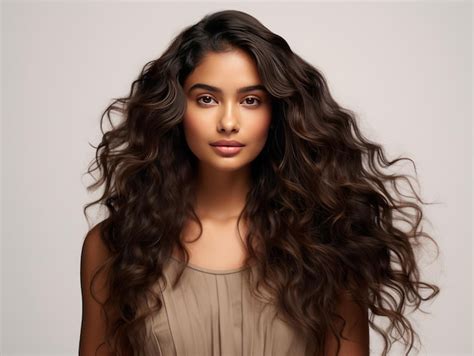Indian curly hair, a captivating symphony of coils, ringlets, and waves, has long adorned the heads of countless individuals, leaving a lasting impression on the beauty landscape. Encapsulating a diverse range of textures from loose spirals to tight corkscrews, this hair type holds a special place in the hearts of those who embrace its inherent charm.

Understanding the Essence of Indian Curly Hair
Indian curly hair possesses a unique combination of characteristics that distinguish it from other hair types.
Texture: Indian curly hair displays a wide spectrum of textures, ranging from loose and wavy (2A-2C) to tightly coiled (4A-4C). The curl pattern is often defined by a combination of genetics, environmental factors, and hair care practices.
Volume: Curly hair typically has more volume than straight hair, as the coiled structure creates pockets of air. This can result in a fuller and more voluminous appearance.
Porosity: Indian curly hair is generally considered to be low-porosity, meaning that it has a tightly packed cuticle layer that protects the hair from external damage. This can make it more resistant to moisture loss and chemicals.
Strength: Curly hair is often stronger than straight hair due to the disulfide bonds that form between its amino acids. These bonds create a more resilient structure that can withstand breakage and damage.
Embracing Indian Curly Hair: A Journey of Acceptance and Care
Recognizing the distinct nature of Indian curly hair is paramount for maintaining its health and beauty. Here are some essential tips for embracing and nurturing this unique hair type:
1. Moisturize Regularly
Curly hair tends to be drier than straight hair, so it requires regular moisturizing to prevent breakage and keep the curls looking defined. Deep conditioning treatments and leave-in conditioners are effective ways to provide deep hydration.
2. Use Gentle Styling Products
Avoid harsh styling products that contain sulfates or parabens, as these can strip the hair of its natural oils. Opt for sulfate-free shampoos and conditioners specifically designed for curly hair.
3. Protect from Heat Damage
Excessive heat styling can damage curly hair, leading to frizz and breakage. Limit the use of blow dryers and curling irons, and always apply a heat protectant spray before using heat tools.
The Science Behind Indian Curly Hair
The distinctive characteristics of Indian curly hair can be attributed to specific genetic factors.
Gene Variants: Studies have identified several gene variants associated with curly hair in Indian populations. These variants influence the hair’s shape, texture, and porosity.
Hormonal Influences: Hormones play a role in hair growth and texture. Fluctuations in estrogen and progesterone levels can affect the curl pattern during pregnancy, puberty, and menopause.
Diversity of Indian Curly Hair Textures
Indian curly hair encompasses a kaleidoscope of textures that vary across different regions and ethnic groups.
Loose Curls (2A-2C)
Type 2A curls form loose S-shaped waves that are often mistaken for straight hair. Type 2B curls are more defined and have a more prominent wave pattern. Type 2C curls have tighter waves that approach the appearance of curls.
Medium Curls (3A-3C)
Type 3A curls are bouncy and well-defined, resembling loose curls. Type 3B curls are tighter and more compact, with corkscrew-shaped ringlets. Type 3C curls are the tightest of the medium curl category, forming tight spirals.
Tight Curls (4A-4C)
Type 4A curls are tightly coiled and coil-shaped. Type 4B curls are even tighter and have a zigzag pattern. Type 4C curls form very tightly packed coils that resemble a steel wool-like texture.
Cultural Significance and Representation
Indian curly hair holds deep cultural and social significance in India and beyond.
Ancient Symbolism: Curly hair has been depicted in ancient Indian art and literature as a symbol of beauty, fertility, and divine favor.
Social Norms: In certain regions of India, curly hair may be associated with specific ethnic or social groups, leading to both positive and negative perceptions.
Modern Representation: Contemporary Indian society is witnessing a growing celebration of curly hair, with numerous initiatives aimed at promoting acceptance and appreciation of this unique trait.
Table 1: Indian Curly Hair Texture Types
| Texture | Curl Pattern |
|---|---|
| Loose Curls (2A-2C) | Loose S-shaped waves to tight waves |
| Medium Curls (3A-3C) | Bouncy and well-defined curls to tight spirals |
| Tight Curls (4A-4C) | Tightly coiled to very tightly packed coils |
Table 2: Indian Curly Hair Care Regimen
| Step | Purpose |
|---|---|
| Shampoo | Cleanse the hair without stripping its natural oils |
| Conditioner | Moisturize and detangle the hair |
| Deep Conditioning Treatment | Provide deep hydration and repair damaged hair |
| Leave-In Conditioner | Keep the hair hydrated throughout the day |
| Styling Products | Enhance the curl definition and reduce frizz |
Table 3: Indian Curly Hair Styling Tips and Tricks
| Tip | Benefit |
|---|---|
| Finger Combing | Detangle the hair without causing breakage |
| Plopping | Define the curls and reduce frizz |
| Diffuser Drying | Dry the hair without damaging the curls |
| Co-Washing | Cleanse the hair without using shampoo |
Table 4: Pros and Cons of Indian Curly Hair
| Pros | Cons |
|---|---|
| Beautiful and voluminous | Can be prone to dryness and frizz |
| Strong and resilient | Requires regular moisturizing and care |
| Unique and alluring | May require specific styling products and techniques |
Conclusion
Indian curly hair, a testament to the beauty and diversity of nature, captivates with its intricate coils, ringlets, and waves. Understanding the unique characteristics and cultural significance of this hair type empowers individuals to embrace and celebrate its distinctive charm. Through proper care and styling techniques, Indian curly hair can radiate health, vibrancy, and confidence. May this article inspire a deeper appreciation for this enchanting hair type and foster a culture of acceptance and admiration.
